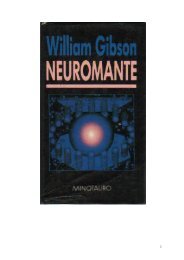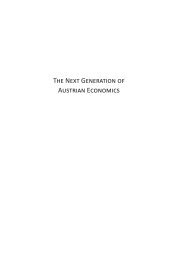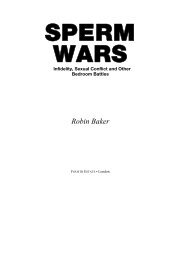- Page 2: e Capitalist and the Entrepreneur
- Page 5 and 6: Copyright © 2010 by the Ludwig von
- Page 8 and 9: Contents Foreword by Doug French In
- Page 10 and 11: Foreword by Doug French Entrepreneu
- Page 12 and 13: v Conversely, the entrepreneur is o
- Page 14 and 15: Introduction As far back as I can r
- Page 16 and 17: ix theory of the firm, preferring t
- Page 18 and 19: xi A final chapter, “Commentary,
- Page 20 and 21: CHAPTER 1 Economic Calculation and
- Page 24 and 25: 5 enforcing contracts, and so on. W
- Page 26 and 27: 7 ownership of the means of product
- Page 28 and 29: 9 With the widespread acceptance of
- Page 30 and 31: 11 bly encouraged by Lange’s famo
- Page 32 and 33: 13 were not isolated social systems
- Page 34 and 35: 15 method of production, allocation
- Page 36 and 37: 17 adequate explanation for the lim
- Page 38 and 39: 19 firm (Boudreaux and Holcombe, 19
- Page 40: 21 terminology). 17 is does not imp
- Page 43 and 44: 24 capitalist. I next discuss
- Page 45 and 46: 26 different from the other fa
- Page 47 and 48: 28 an agreement that describes
- Page 49 and 50: 30 failure to discover an exis
- Page 51 and 52: 32 Economic Calculation All en
- Page 53 and 54: 34 price as the transfer price
- Page 55 and 56: 36 studies the design of ex an
- Page 57 and 58: 38 primary tool, and that econ
- Page 59 and 60: 40 is being generated on the f
- Page 61 and 62: 42 tender offer rather than pr
- Page 63 and 64: 44 corporation,” in which
- Page 65 and 66: 46 who hires an employee alert
- Page 67 and 68: 48 takeover). Because sharehol
- Page 69 and 70: 50 authorities. However, the a
- Page 71 and 72: 52 many acquisitions are later
- Page 73 and 74:
54 property in all markets, es
- Page 75 and 76:
56 of production has no market
- Page 77 and 78:
58 and Lehn, 1990), creating o
- Page 79 and 80:
60 in the 1960s has been descr
- Page 81 and 82:
62 Of course, this argument as
- Page 83 and 84:
64 and Mulherin argue that cor
- Page 85 and 86:
66 guided by what was and is,
- Page 87 and 88:
68 upon which most economic th
- Page 89 and 90:
70 primarily to business decis
- Page 91 and 92:
72 substituted costlessly from
- Page 93 and 94:
74 “OLD” PROPERTY RIGHTS T
- Page 95 and 96:
76 a time dimension as well as
- Page 97 and 98:
78 on the concrete form the ca
- Page 99 and 100:
80 appropriate, and so on. Mor
- Page 101 and 102:
82 resource owners “active,
- Page 103 and 104:
84 The Boundaries of the Firm
- Page 105 and 106:
86 as derived judgment, meanin
- Page 107 and 108:
88 However, the concept of cap
- Page 109 and 110:
90 performing the entrepreneur
- Page 112 and 113:
CHAPTER 5 Opportunity Discovery and
- Page 114 and 115:
95 organization and strategy by ado
- Page 116 and 117:
97 discussed in chapter 2 above, be
- Page 118 and 119:
99 theory of profit and loss—a co
- Page 120 and 121:
101 Opportunities: Objective or Sub
- Page 122 and 123:
103 Contemporary entrepreneurship s
- Page 124 and 125:
105 decision making itself. is sugg
- Page 126 and 127:
107 One approach is to focus not on
- Page 128 and 129:
109 a given, defining opportunities
- Page 130 and 131:
111 Chapter 4 above argues that Aus
- Page 132 and 133:
113 incentives, limiting opportunis
- Page 134 and 135:
115 be regarded as a bundle of hete
- Page 136 and 137:
CHAPTER 6 Risk, Uncertainty, and Ec
- Page 138 and 139:
119 defense of “frequentism,” t
- Page 140 and 141:
121 thing ontologically separate wh
- Page 142 and 143:
123 work, either decision making is
- Page 144 and 145:
CHAPTER 7 Price Theory and Austrian
- Page 146 and 147:
127 given their substantial work on
- Page 148 and 149:
129 Specifically, Vaughn maintains
- Page 150 and 151:
131 Rothbard’s treatise “must h
- Page 152 and 153:
133 no means accepted the core prin
- Page 154 and 155:
135 Equilibrium in Austrian Price T
- Page 156 and 157:
137 tracing the effects of an incre
- Page 158 and 159:
139 tions about the marginal utilit
- Page 160 and 161:
141 can prevail over the various
- Page 162 and 163:
143 prepared to accept ultimately (
- Page 164 and 165:
145 ical consistency of market-leve
- Page 166 and 167:
147 e early Austrians’ emphasis o
- Page 168 and 169:
149 Salerno (1991, 1999b) offers a
- Page 170:
151 take place in real markets are
- Page 173 and 174:
154 often understated. e Inter
- Page 175 and 176:
156 We must be very careful no
- Page 177 and 178:
158 Linux, that allow users to
- Page 179 and 180:
160 p. 21) favors a public own
- Page 181 and 182:
162 and calculation problems n
- Page 183 and 184:
164 empirical researchers call
- Page 185 and 186:
166 with important government
- Page 187 and 188:
168 Kenneth Galbraith. is grou
- Page 189 and 190:
170 deal with an increasingly
- Page 191 and 192:
172 Professor of Political Eco
- Page 193 and 194:
174 his analysis is logical an
- Page 195 and 196:
176 and Wieser’s colleague O
- Page 197 and 198:
178 suffered a dramatic revers
- Page 199 and 200:
180 immense, has very recently
- Page 201 and 202:
182 expansion, then, is self-r
- Page 203 and 204:
184 Hayek and Austrian economi
- Page 205 and 206:
186 statement that “Mises hi
- Page 207 and 208:
188 choosing clarity and relev
- Page 209 and 210:
190 with my machine, I hold re
- Page 211 and 212:
192 and often unpredictable wa
- Page 214 and 215:
References Abell, P., Teppo Felin,
- Page 216 and 217:
197 ———. 1987. “e entrepren
- Page 218 and 219:
199 Boot, Arnoud W. A., Todd T. Mil
- Page 220 and 221:
201 Chiles, Todd H., and omas Y. Ch
- Page 222 and 223:
203 Davis, Lance E., and Douglass C
- Page 224 and 225:
205 ———. 2002. “Economic or
- Page 226 and 227:
207 Gertner, Robert H., David S. Sc
- Page 228 and 229:
209 ———. 1934. “Carl Menger
- Page 230 and 231:
211 ———. 1992. e Fortunes of
- Page 232 and 233:
213 Hülsmann, Jörg Guido. 1997.
- Page 234 and 235:
215 ———. 2005. “Property ri
- Page 236 and 237:
217 ———. 2006. “Foreword”
- Page 238 and 239:
219 Langlois, Richard N., and M. Co
- Page 240 and 241:
221 Machlup, Fritz. 1934. Führer d
- Page 242 and 243:
223 Milhaupt, Curtis J. 1997. “e
- Page 244 and 245:
225 Oakley, Allen. 1999. e Revival
- Page 246 and 247:
227 ———. 1962. Man, Economy,
- Page 248 and 249:
229 Saussier, Stéphane. 2000. “T
- Page 250 and 251:
231 Sobel, Robert. 1984. e Rise and
- Page 252 and 253:
233 Weston, J. Fred, Kwang S. Chung
- Page 254 and 255:
Index A agency theory, about, 35, 4
- Page 256 and 257:
237 entrepreneurship, see also capi
- Page 258 and 259:
239 relationship to Hayek’s thoug
- Page 260:
About the Author Peter G. Klein is








